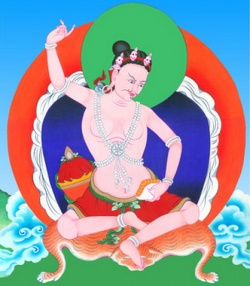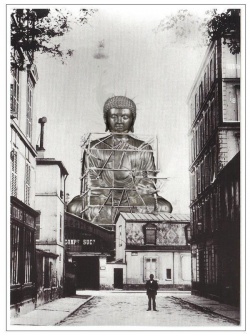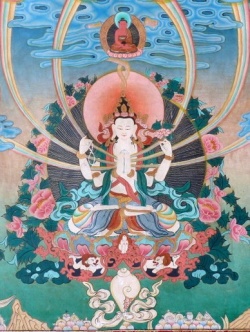A Critical Estimate of the Non-soul Theory of the Buddhist Philosophers
The Buddhists of the Sautrāntika-Yogācāra school have vehemently opposed the existence of a permanent self behind the psychical phenomena either as their substratum or as their condition. But they postulate the existence of pure, absolute consciousness, though momentary, bereft of subject-object determinations in the state of Nirvāṇa. Though the possibility of total extinction of all conscious existence is found to be adumbrated in the Tattvasaṅgraha and alluded to in the writings of rival schools, we shall not however concern ourselves in this context with the metaphysical merits or drawbacks of this theory, as it will be fully discussed and examined in the chapter on Nirvāṇa. Śāntarakṣita. tells us that the gap between the Buddhistic and the Vedāntic conception of consciousness as the ultimate principle is but very narrow, though it is fundamental.
The Vedāntists too have denied the existence of individual soul-centres (Jīvātman) as metaphysical entities and in this they are at one with the Buddhists. The issue of debate hangs upon the permanence or impermanence of consciousness. There is absolutely no difference of opinion regarding the impersonal and impartite character of consciousness too. The Buddhists hold consciousness to be of momentary duration, albeit the stream of consciousness-units is one unbroken and uninterrupted procession and in this respect of eternal duration, there is agreement, too, between the two schools of thought. The continuum of consciousness as an ontological reality whether in the series or in the unity is accepted as a fundamental reality and so for all practical purposes the two positions do not differ in a material respect.
[Page 196] But practical considerations are not the only thing that carry weight with philosophers. The difference of metaphysics is far too deep and uncompromising, though to the commonplace mind, it would perhaps appear to be a distinction without difference. The difference between the two philosophies is therefore based upon a fundamental ground and. neither of them can be expected to capitulate to the other, as this would imply the entire change of outlook and philosophic orientation. But a dispassionate critic, when confronted with a metaphysical tangle of this type, has got to make his own decision and to pronounce an unbiassed verdict either in favour of one or against the other. It is very seldom that the critic can come with offers of compro? mise, as compromise proves very often to be suicidal to philosophy. Compromise is a virtue in practical life, because it ensures the harmonious co-operation of the members of a community, which disagreement and difference would render impossible. But difference of opinion does not spell any such danger, if it does not involve a fundamental antagonism in ethics and social life. So the practical work-a-day man of the world has no reason to sound the tocsin of alarm if philosophers differ between themselves, as decent philosophy does never stoop below wordy warfare.
Now, the Buddhist maintains that consciousness must be believed to vary with its contents. Thus, the consciousness of red is different from the consciousness of blue. If they were one undivided consciousness, then, the contents should be felt all at once and not in a graduated series, which is the actual fact. Nor is there any warrant either from experience or from logic to suppose that consciousness is a principle apart and distinct from its contents, because we feel the two together and as identical. So one consciousness must be held to be distinct from another consciousness and the apparent unity and identity of self-consciousness must be explained as a psychical fiction, generated by the homogeneity of the consciousness-units. The Sāṅkhyas put forward their epistemological theory that cognitions are processes [Page 197] and affections of a thin, attenuated intelligence-stuff (buddhi) which are as much material and unspiritual as any other material changes, but these are quickeued and illuminated and thus spirit tualised by the light of the spirit reflected upon it.
The Vedāntists, too, with minor differences among themselves, which are negligible for our purpose, almost unreservedly accept this epistemological device of the Sāṅkhyas and the objective of all this is to maintain the supposed integrity of the spirit, standing aloof from the psychical processes. But this is only an expedient, ingenious though, devised to maintain a pet theory, -which has no logical or psychological evidence to support it. If the contents of consciousness were really different and distinct from consciousness per se, the knowledge of these contents would become absolutely unaccountable. What is the criterion of knowledge? What is the explanation that one thing is known and another is unknown save and except this that one thing enters into consciousness and becomes identical with it? But how can a thing, material and unconscious in itself, come to be identified with consciousness, which is its complete anti-thesis? The Sautrāntikas tide over this common difficulty of all epistemology by positing the existence of an intermediary, viz., the image or likeness of the material object imprinted on consciousness. The process is something like photography.
The Vedāntists, on the other hand, think that these Buddhists have come very near the truth, but their philosophy suffers shipwreck at the very sight of the harbour. We admit, the Vedāntists argue, that knowledge of a fact cannot be explained if the fact stands in its sacred aloofness from consciousness. There must be some relation., between the two and the relation of causality or objectivity (viṣayatā or uddyeśyatā) which is requisitioned by the Realists, cannot adequately explain the intimacy and immediacy of the relation involved in knowledge. There may be a case of causality between two material facts and yet there is no resultant knowledge.
And a material object may be the aim and objective of our physical endeavour, but such [Page 198] endeavour fails to remove the cover of ignorance that envelops it.1 You may plead that the relation is unique and the fact of illumination proceeds from consciousness to the object and so knowledge becomes possible. Yes, but this is the very crux of the problem. Your explanation only states the problem and assumes the very fact which you are called upon to explain. The Buddhist thinks that this relation is one of complete identity (sahopalambhaniyamād abhedo nīlataddhiyoḥ).
But this is opposed to the testimony of experience. The; contents cannot be believed to be absolutely identical with consciousness, because they are felt to be distinct, external and possessed of a long or short magnitude, whereas consciousness is felt inside and as an amorphous principle without any. geometrical dimension. So the two cannot be lumped together. But unless they are identified, they cannot be supposed to be illumined and revealed. Illumination is the property, nay, the very self of consciousness and unless the contents are supposed to be taken into and integrated with it, they cannot be known. Knowledge is a peculiar relation—it is neither one of complete identity nor of complete difference.
It is a peculiar relation—something indescribable. There is difference between consciousness and its contents, but the difference is not real. There must be identity between the two, no doubt, without which no knowledge can be supposed to be possible. But this identity cannot be a real, absolute identity. It is something equally indescribable. Consciousness is self-luminous and as such can illumine its own identity and with regard to external objects it is [Page 199] perfectly uniliuminative. So the very possibility of knowledge demands that the two must be brought together in a relation of identity, but this identity cannot but be illusory and fictitious.2
Now, the Buddhist philosopher argues into the momentariness of consciousness on the ground of the variation and the fluxional nature of the contents of consciousness and he bases his conclusion upon the relation of identity between consciousness and its contents. And he explains away the felt unity of consciousness as a psychological fiction by an appeal to the palpable variability of these contents. But these are pure assumptions which militate against sound logic. It has been proved that the relation of consciousness and its contents is neither one of absolute identity nor one of absolute difference, as both these are equally felt in experience to be the case.
But identity and difference cannot both be predicated of the same phenomenon, as it infringes the fundamental Jaws of thought, viz., the Law of Contradiction and the Law of the Excluded Middle. The said relation therefore transpires to be an unreal, illusory superimposition just like the illusory superimposition of silver upon the shell. The relation of consciousness to its superimposed contents is therefore one of illusory identity and the difference of one content from another is equally false and illusory.
And a false identity and a false difference cannot be made the basis of a philosophical argument. There is a felt difference between one cognition and another, but this difference is purely fictitious [Page 200] and a fictitious difference cannot entail a substautive difference in consciousness. A fictitious difference cannot affect the integrity of the reality, much less can it indues a real distinction. The shell may erroneously be perceived alternately as silver or as lead. But the distinction of lead and silver does not touch, the identity of the shell and so cannot split it up into two. By similar logic the difference of contents, which have been proved to be illusory superimpositions, cannot be legitimately supposed to introduce a real distinction into consciousness.
Consciousness; therefore, should, in deference to the demands of logic, be regarded as a simple.identity, an impartite whole, an eternal verity, with no ontological difference in itself. It is a self-illuminative principle without origin, decay and death, existing as the sole, witness and illuminator of the cosmic panorama, which hangs as a pall and 'as a c!oud over it. Ontologically speaking, it is. nothing short of a vain show, a mysterious appearance, an idle, phantasmagoria—the creation of an equally illusive and unreal avidyā (nescience), which however is not a psychological phenomenon nor a logical fiction, but an elusive category that cannot, be described in metaphysical terms either as an absolute aught or as an absolute naught.
Experience too does not lend support to the Buddhist conception of multiple consciousness-units. The consciousness of red is felt to be distinct from the consciousness of blue, no doubt but distinction is not the only note in it, the identity of consciousness is equally a felt fact. The Buddhist believes this felt Unity of consciousness to be an illusion and he bases this belief upon the apparent multiplicity of contents. With equal logic one might explain away the multiplicity of contents as fiction and establish the unity of consciousness to be the reality.. So; appeal.to experience is perfectly unavailing and its testimony is inconclusive and conflicting. The two opposite characters—unity and difference—cannot both be true, as they involve a contradiction in terms.
Which of the two then is to be believed as the reality and which again as false appearance? Difference and [Page 201] non-difference cannot both be true and if one of them is to be discarded, we must give up the aspect of difference as false appearance over the basic foundation of unity or non-difference, because difference cannot arise except on the foundation of two units, which are in their nature simple unities. If one of the two units be absent, the concept of difference becomes impossible, as each of the units constitutes its foundation and pivot, and if the foundation be lacking, how can it subsist? But the case of unity is quite different. It is perceived in and by itself and without any reference to any other unity.
Difference however is contingent upon unity and without unity its existence is inconceivable. And if we are faced with the alternative of rejecting one, we must perforce reject the aspect of difference as false superimposition and accept the factor of unity as the basic reality, because unity is the pre-supposition of difference and even if difference be accepted to be the final truth, unity will have to be accepted, as difference without unity as its basic support is a chimera. So between unity and difference we must accept unity as the reality since unity cannot be rejected as it is the constituent factor and is the raison d’etre even of difference. The Buddhist philosopher commits the blunder of unpardonable abstraction when he seeks to explain away the unity of consciousness on the basis of difference of contents, which in its turn, we have seen, presupposes the fact of unity as its very foundation and essence.
- Footnotes:
1.
hānādijananād hānādibuddhīnām artbaviṣayatvam, arthaviṣayahānādibuddhijananāc cā’rthasaṃvidas tadviṣayatvam iti cet, tat kiṃ dehasya prayatnavadātmasaṃyogo dehapravṛttinivṛttihetur arthe ity arthaprakāśo’stu. jāḍyād dehātmasaṃyogo nā’rthaprakāśa iti cet, nanv ayam svayaṃprakāśo’ pi svātmany eva khadyotavat prakāśaḥ, arthe tu jaḍa ity upapāditam.
Bhā. ad Br. Sū. 1.1.1., p. 36.
Cf., dṛśyavargasya saṃvidbhinnatābhyupagame saṃvidaḥ svātmānaṃ prati prakāśatvaṃ hy abhedasaṃbandhenai’va kḷptam iti taṃ prati sā jadarūpā dehātmasaṃyogatulyā na prakāśarūpā.
K. T. P., ad ibid.
2.
na ca prakāśasyā’tmāno viṣayāḥ, te hi vicchinnadīrghasthūlatayā’nubhūyante, prakāśas cā’yam āntaro’sthūlo’naṇur abrasvo’dīrghuś ce’ti prakāśate. tasmāc candre’nubhūyamāna iva dvitīyaś candramāḥ svaprakāśād anyo(?)’rtho’nirvacanīya eve’ti yuktam utpaśyāmaḥ.
Bhā. ad 1.1 1, pp. 86-37.
Cf. saṃvit svaprakāśe’ti tasyāḥ svābhinna eva prakāśarūpatvasya kḷptatvāt svābhinne dṛśyavarge tasyāḥ prakāśarūpatā na sambhavati, tāttvikaś ca dṛg dṛśyayor abhedo na yujyate, ato dṛśyavargasya saṃvidvivartatayā’nirvacanīyena tudabhedena prakāśamānatā.
K.T.P., ad ibid, p, 37.




